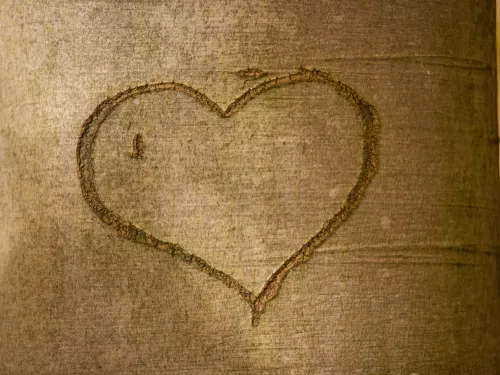
The Will You Marry Me Tree
Welcome to the Will You Marry Me Tree story - a story part of the Cromer's Wood Story Trail
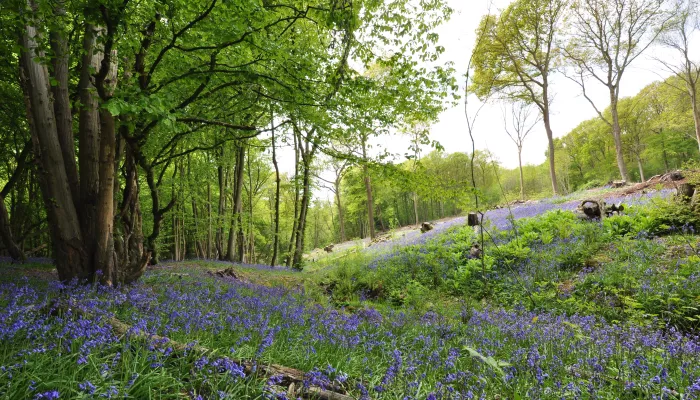
John Sudds has known these woods all his life and has a strong connection with them. We all know how important maintaining the coppice cycle is for these woods, but what is it like to be the coppice worker?
He's been 'wooding' in Cromers Wood for 50 years and tells Hand of Doom Productions how he fears the ancient practice will die out and how harvesting wood can lead to some misunderstandings among the public as well as some unexpected discoveries.

Illustration by Megan Metcalf
Some people think Cromers Wood exists just so they can walk their dogs. You’re in there with your tractor and they see you cutting trees down and they don’t like it but you’ve got to remember the trees were planted to harvest. I’ve had lots of people shouting at me for ‘destroying the wood’. I’ve said to them, ‘if you do your homework, you’ll find we’re actually coppicing, not destroying it’. Young trees absorb more carbon than larger and older trees so the younger you cut it, the better for the environment. It’s a very sustainable and ancient way of managing woods. Cromers was planted to coppice – it’s no different to the corn field next door. There are some trees I’ve cut three times now - usually when they’re about 16 or 17 years of age. If you cut it down to the stump, it will grow again. It’s pruning, basically.
I’ve been wooding for 50 years now and I own the company. My dad did the same thing. When I left school, I did this for someone else for a little while and then worked for another fencing firm. When they didn’t have any overtime for me, I started up my own little business on the side just to earn a little more money. Then, seven years later, my wife’s granddad who used to run a big fencing company in Faversham asked me to go into partnership.
The wood used to be owned by Shell and then, about 20 years ago, they handed it over to the Wildlife Trust and one of the conditions was that it was continued as a coppice wood. Henry Scamp used to have a shed in the wood and he made all sorts of stuff up there. When he retired six years ago, he asked me if I’d take over and I bought all his tools. In fact, I cut my very first wood in Cromers in 1982 for a couple called George and Anne who used to make chestnut posts and rails.
We take the sweet chestnuts to make fencing because it’s a very strong tree but splits easily. We don’t use birch or ash because it doesn’t last very long. You get 20 years’ life from a chestnut. Most chestnut was planted with oak trees; that’s why it’s known as underwood. If you look at an oak tree in the middle of a field it will be short, fat and ugly. If you look at one in a wood, it will be tall and straight because the chestnut will draw it up for competition for light, so the chestnut will be above the oak. In the past, you’d use oak for building boats, so you’d want their trunks nice and straight and the chestnuts made that happen. Some of the oaks in Cromers are probably around 100 years old.
Chestnut was planted by the Romans and originally came from Spain. They used the wood for certain jobs and then the chestnuts were mashed into pulp to feed the army. The Romans used a lot of the tree at the top to make faggots, which are not what you think. They’re bundles of branches which they put in the ground when they were building roads. If you get a lot of wet ground, they’d put these faggots first before they put the substrate on top.
The faggots I make are used to stop riverbank erosion, so they’ll be used to line the bank and then they fill up with silt and stop the bank washing away. I’ve done a lot of those. They go all over the UK via a company which specialises in erosion. They use faggots and lots of different types of posts. The company also make special matting and we make the posts to hold the matting up. A lot of the faggots are going abroad to Belgium and France now because no one is making them there. In Kent, they used to make snow fences out of them but now they use orange plastic fencing and snow ploughs. I used to make faggots out of birchwood as well, for steeplechasing jumps, because it’s a much softer wood for the horses.
Let me explain how the process works. First, you cut the wood and bring it back to the yard on a tractor. Hopefully not being told off by dog walkers. Then you put the wood in a saw bench and cut it all into different sizes, depending on what you need. With the fencing, it probably takes half an hour to make a bundle of 25 pales which are the vertical planks of the fence. You look at the pole of wood to see how to cut it. Every bit of wood is different. Then you make up a frame and put a piece of wood into it and work out how many pales it will make. Then you bash it with a mallet and you can see where it will split and where to steer it, and then you split it with a dull axe (more interesting than it sounds!). When you get a half, you can see how many pales you can make and then tip the ends. That’s when you make one of the ends pointed. A lot of people see the pointy end thinking that’s the bit you stick into the ground but it’s actually to allow the rainwater to run off.
Around 15 to 20 years ago, business was at its peak and we were one of the largest fencing companies around. We used to have arctic lorries collecting the wood to go to Manchester, Scotland, Nottingham, Wales. Around 20 pallets would go on the floor, then you’d stack them on top, so altogether you’re talking about 1,500 bundles. But since then, orders have gone down.
The trouble is you just can’t get anyone to do wooding these days. You can’t use a machine to make the pales and it takes a long time to learn it and it’s nearly finished this trade because you can’t find anyone to do physical work anymore. No one wants to do it. When I left school, I had three brothers and we were all doing wooding but they’re doing other things now, 3 painting and decorating where you can earn more money. I used to buy wood from other people like Henry but they’ve all just vanished, no one wants to do it. I’ve tried training people and setting them up but they give up. You wouldn’t believe how many people I’ve set up in business. Bought them tractors and somewhere to work but it’s too much like hard work and they’d rather do something else. To be fair, it really is hard work. You have the weather to put up with which is always a problem. With a lot of people, as soon as the first thing goes wrong they throw in the towel. Your hands are frozen in the winter, or it’s too wet. Then you get the other extreme when it gets so hot, you can’t have a fire in the wood because of the danger of it spreading. So, you have to leave everything until later on.
And the money hasn’t increased. If you put prices up then it will make other wood cheaper. So you’re competing with saw-cut fencing from, say Russia, and you can’t compete with those prices. Everything in this job is handmade and we all know how much labour costs.
Last year, I made 1,000 faggots but I’ve not had a single order this year. It’s the first year I’ve not sold them for riverbanks. I also used to make the little wooden stakes – to kill vampires – only kidding, to hold up newly planted trees and we supplied all the ones for the High Speed Rail Link. But now all the Government grants to plant trees have dried up and so no one’s planting trees. We also used to supply to Windsor Park and Bernard Mathews’ estate in Norfolk and I used to supply around 15 garden centres but a lot of them have closed. People don’t seem to care about where the wood comes from nowadays if they can get it cheaper from one of the big DIY superstores.
I don’t think I’ll be put out of business because I have all the skills to do the different jobs but I don’t know what will happen to the business or to Cromers Wood when there isn’t anyone like me to harvest the wood. I guess it will be used in the local power station at Sandwich where they’ll chip it and burn it.
I’ve seen a few weird things over the years. I got to the wood in the morning once and there was evidence that lots of people had been in the woods... lots of clothing left behind and empty beer cans and apparently someone had made a ‘movie’ in the woods. We’ve occasionally come across the aftermath of a rave but we don’t get them anymore. We get a few stolen cars and we found a voodoo doll once too. They’d nailed a shop-bought doll to the tree and put a photo of a bearded man on its face with pins in it. We left that well alone…

Welcome to the Will You Marry Me Tree story - a story part of the Cromer's Wood Story Trail
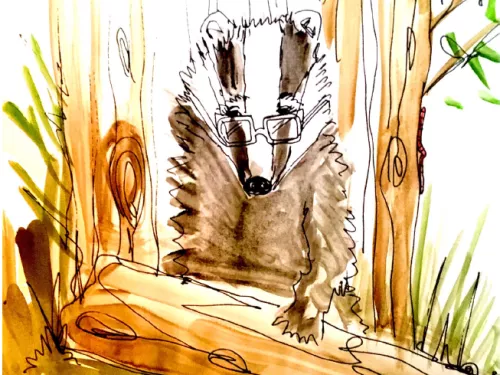
Welcome to the Very Brittle Badger - a story part of the Cromers Wood Story Trail

Welcome to the story The Sacred Monument of Nom - part of the Cromers Wood story trail
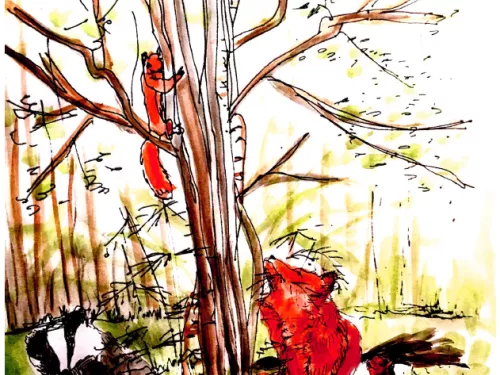
Welcome to the Rowan and the Birch story - a story from the Cromers Wood Story Trail
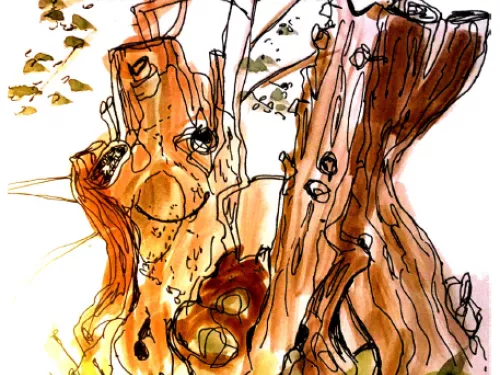
Welcome to the 'Straight To The Heart' story, part of our Cromers Wood Story Trail.
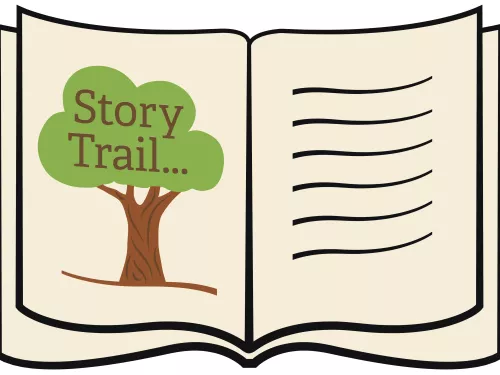
Using local features and wildlife as inspiration, six stories have been written from the point of view of the local inhabitants of Cromers Wood.